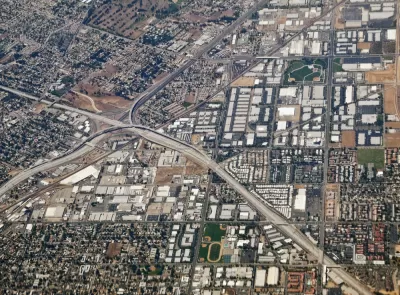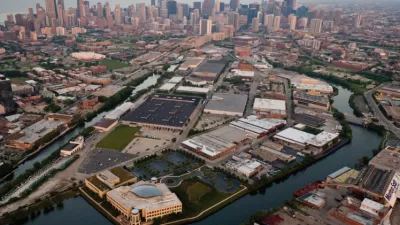The final version of a "Good Neighbor Policy" adopted by Riverside County in November fell short of the original author's intentions.

Paloma Esquival reports on the effort to approve a "Good Neighbor Policy" that would have required a buffer between large warehouses and residences in Riverside County in Southern California's Inland Empire Region.
The Riverside County Board of Supervisors recently approved the "Good Neighbor Policy," but with such significant changes that the policy's original backer voted no on the final produce.
Riverside County Supervisor Kevin Jeffries pushed for a policy that would have required a 1,000-foot buffer between warehouses and residential neighborhoods in response to a wave of construction in the region. "In the last decade, more than 150 million square feet of industrial space, the vast majority of it warehouses, has been built in the Inland Empire, according to real estate services company CBRE," writes Esquival.
“We blew it,” [Jeffires] said. “The standards that were adopted are really no standards at all.”
Regulatory constraints on industrial development in Riverside County proved unpopular, as critics of the idea cited the protections of the California Environmental Quality Act and the need for jobs in a region struck particularly hard by the effects of the Great Recession.
Among the concessions granted in the final, approved version of the Good Neighbor Policy: 1) individual supervisors retain the "ability to opt out of the policy in their districts, and 2) "instead of the 1,000-foot buffer that Jeffries had proposed, they adopted a 300-foot buffer, measured from warehouse loading docks to property lines," reports Esquival.
FULL STORY: Efforts to rein in the Inland Empire’s warehouse industry fall flat

Planetizen Federal Action Tracker
A weekly monitor of how Trump’s orders and actions are impacting planners and planning in America.

Chicago’s Ghost Rails
Just beneath the surface of the modern city lie the remnants of its expansive early 20th-century streetcar system.

San Antonio and Austin are Fusing Into one Massive Megaregion
The region spanning the two central Texas cities is growing fast, posing challenges for local infrastructure and water supplies.

Since Zion's Shuttles Went Electric “The Smog is Gone”
Visitors to Zion National Park can enjoy the canyon via the nation’s first fully electric park shuttle system.

Trump Distributing DOT Safety Funds at 1/10 Rate of Biden
Funds for Safe Streets and other transportation safety and equity programs are being held up by administrative reviews and conflicts with the Trump administration’s priorities.

German Cities Subsidize Taxis for Women Amid Wave of Violence
Free or low-cost taxi rides can help women navigate cities more safely, but critics say the programs don't address the root causes of violence against women.
Urban Design for Planners 1: Software Tools
This six-course series explores essential urban design concepts using open source software and equips planners with the tools they need to participate fully in the urban design process.
Planning for Universal Design
Learn the tools for implementing Universal Design in planning regulations.
planning NEXT
Appalachian Highlands Housing Partners
Mpact (founded as Rail~Volution)
City of Camden Redevelopment Agency
City of Astoria
City of Portland
City of Laramie





























